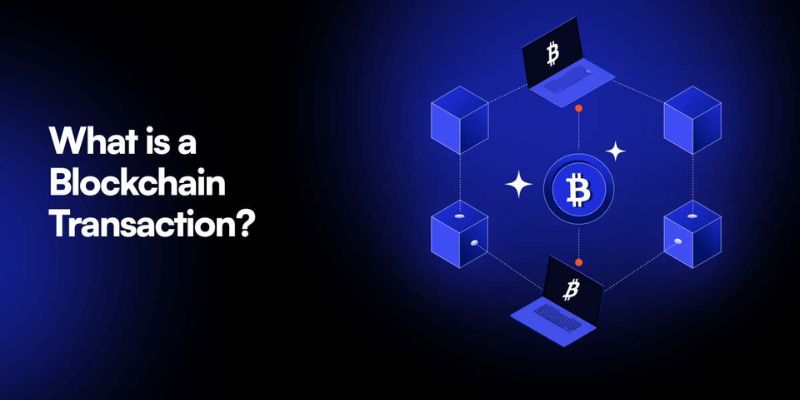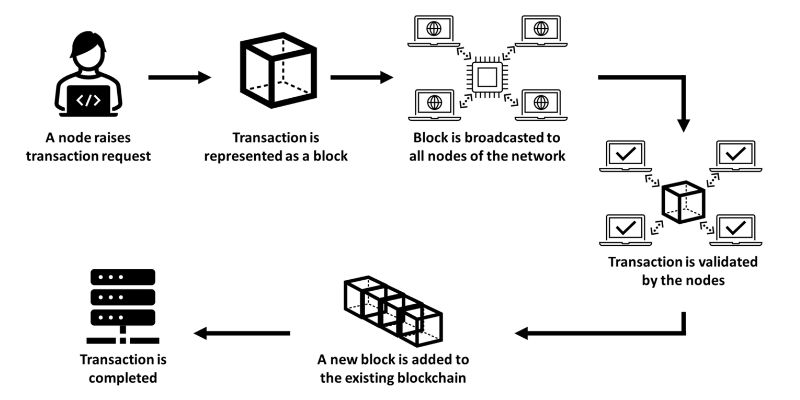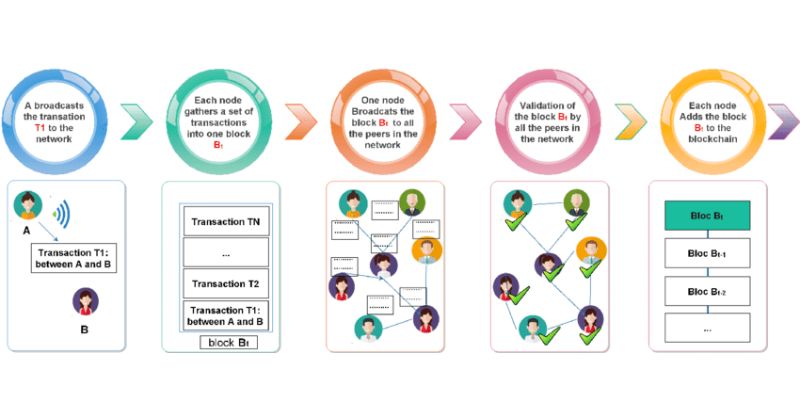Ever scratched your head and wondered, “What is a transaction in blockchain?” You’re not alone. It’s the heartbeat of all blockchain action, yet many folks still struggle to grasp its nuts and bolts. Let’s break it down. Picture a blockchain transaction as a secure note passing from one person to another, with everyone keeping track. Simple, right? But there’s more to these digital notes; they’re the core of a tech revolution. Stick with me; I’ll walk you through the ABCs of these crypto exchanges. We’ll dig into how they live in digital ledgers, why they’re ironclad safe, and what crazy new forms they might take soon. Ready to become a blockchain whiz? Let’s dive in.
Unveiling the Basics of Blockchain Transactions
Defining a Blockchain Transaction
A blockchain transaction is like a promise made and kept without fail. Picture you’re in a game, trading cards with friends. Each card swap is a transaction. But in our game, blockchain, it’s not just any old swap. It’s a special kind of trade where you use digital money, called cryptocurrency, to buy stuff or send money to friends across the Internet.
In traditional games, you just hand over a card and hope the other person plays fair. With blockchain, it’s as if there’s an unbreakable rule book that always checks you’re playing nice. That’s what makes blockchain special – it’s a trusty way to make deals with anyone, anywhere, without needing someone else, like a bank, to say it’s okay.
Each transaction is a set of digital keys, like secret codes, that lock in your deal. Once made, no one, no matter how sneaky, can erase it. This magic trick is done by a lot of computers agreeing the trade is good. When they all agree, it’s like the deal gets a gold star and goes into a grand book for everyone to see.
The Role of Digital Ledgers in Recording Transactions
Now imagine this grand book is a never-ending tower of digital pages stacked one on top of the other. That’s a digital ledger. It’s where all the gold-starred deals – the transactions – get recorded. This ledger isn’t hidden in a bank’s back room. It’s out in the open, shared across the globe on many computers. We call it distributed ledger technology.
Every time you make a transaction, it’s like writing in this book with ink that never fades. What’s super cool is that your note in the book fits perfectly with the notes that all the other players add before and after you. It’s as if all the pages lock together like puzzle pieces.
To add your transaction to this book, you start with your secret codes. If those codes are good, computers on the network, also known as nodes, check them out. Then, they make sure you’re not trying to cheat by spending your digital money twice. This check-up is called transaction verification. When all’s good, they add your deal to the newest page, called a block.
Then, something called a hash function seals the deal. Think of it like putting your page in an unbreakable safe. Only the right secret code can open it, and that’s your key. Other keys join yours to make that page super safe. This is the part where blockchain gets its name – each page links to the one before, forming a chain of blocks.
Finally, smart contracts can make this even fancier. They’re sets of rules that automatically do the deal if everyone follows the plan. No need for a middleman. And that’s where tech takes us to a new level of playing fair, no backsies, no crossed fingers, just clear, clean trades, every time.
So next time you hear about blockchain transactions, think of that unbreakable book of deals, all locked safe and sound, with smart contracts making sure the game stays honest. It’s like the coolest, smartest game of trading cards ever – and we’re just getting started.
The Mechanics of a Transaction on the Blockchain
Transaction Structure and Data Elements
Let’s break down how a blockchain transaction works. Picture a digital lockbox that everyone can see, but only you have the key to open it. A transaction is like sending a secret message inside this lockbox to someone else. Now, imagine this happening in a busy town square. But here’s the twist: the whole town agrees you really did send the message.
Every blockchain transaction has important parts. Think of it like a recipe. First, there’s the sender’s address—like a return label on a package. Then, the receiver’s address—where the package is going. We add the amount being sent, of course. Now, stir in a pinch of unique code called a hash to keep it safe. Finally, sprinkle in a nonce— a special number used just once to lock it all up tight.
When you hear “blockchain,” think of a chain of these digital lockboxes or “blocks.” It’s like a train made up of lockbox-cars. Each block has a list of transactions that everyone in the network checks. Once it’s full, the town square nods in agreement, and the block locks into the train.
Transactions in a blockchain are always playing “follow the leader.” The new blocks always tag onto the end of the chain. This way, every block is connected, back to the very first one. It’s a long chain of trust stretching all the way back in time!
How Smart Contracts Automate Transactions
Smart contracts are the cool kids on the blockchain. They’re like vending machines. You pick what you want, drop in your coins, and voila! You get your candy bar, no human needed. But smart contracts deal with all kinds of deals, not just snacks.
These contracts live on the blockchain. They follow rules we set up from the start. When conditions are right, they spring into action all on their own. Let’s say you bet your friend a movie ticket that it will rain tomorrow. With a smart contract, if it pours, the digital ticket pops out of the blockchain and into your friend’s wallet, just like magic. You don’t even have to talk!
Smart contracts can be big helpers. They can replace middlemen, making things cheaper and faster. Imagine buying a house with a smart contract. If you pay up, the digital key lands in your pocket right away, without any extra fuss. This means no waiting on people to make things happen.
Blockchain transactions whisk information across the world quickly and safely. They create records no one can change, ever—like carving words in stone, but in the cloud. And just like magic, smart contracts make sure deals happen just as planned—no hiccups, no mix-ups, just smooth sailing! So, in blockchain land, every deal, game, or trade is fair and square thanks to these smart little contracts making sure everyone plays by the rules.
Ensuring Transaction Integrity and Security
The Significance of Public and Private Keys
Let’s dig into how we keep our blockchain deals safe. You know how you have a key for your house? It’s like that, but for your digital cash. Public and private keys are buddies in the blockchain world. They work together to lock and unlock your money’s safe. Each person has two keys: one is a secret key, the other, everybody can see. The public one is like your house number; anyone can know it. The private one is your house key; you don’t share that!
When you send blockchain cash, you use your private key. This is like signing your name on a check. It proves that money coming out is really yours. It’s a digital ‘Okay, you can take this!’ Nobody else can fake this signature because only you have the secret key. After you sign, your public key checks it. It says ‘Yep, that’s a match!’ and the deal is good to go. This two-key dance makes sure your transactions are safe.
Consensus Mechanisms: Proof of Work vs. Proof of Stake
Onto the next big thing in blockchain safety: making sure everyone agrees on who owns what. In the blockchain club, we need rules to agree on transactions. That’s where consensus mechanisms come in. They are like a club vote, but way faster!
“Proof of Work” is one way; it’s like a tough math problem. Computers race to solve it. The one that finishes first wins the right to add new records or blocks of transactions. It’s hard work, like mining for gold, which is why we call them miners. They get a prize for their hard work, some fresh digital coins.
Then we have “Proof of Stake”. This one is different. You don’t race; you get chosen based on how much digital cash you already have. It’s like being a big investor in a company and getting a say because of it. Less work, same result: we all agree on the book of transactions.
Both ways have the same goal: making sure our blockchain history book is true and fair. It’s how we make sure no one cheats and spends their digital cash twice. Plus, they both keep the whole system running smooth. It’s super important because it means we can all trust our digital bucks to be safe and sound.
The Future of Blockchain Transactions
Advancements in Blockchain Scalability and Speed
Have you heard folks chat about blockchain and wonder what’s up with that? Well, let’s dive into a super cool part: blockchain transactions. These are like passing notes in class, but way more high-tech and secure. When someone sends cryptocurrency, that’s a transaction right there. But here’s the kicker: everyone can see the note but only the person with the secret code, called a private key, can open it.
Now, blockchain is growing up fast! It used to be kind of slow because every note had to be checked by many people, which takes time. But smart folks are on it, working to make it quicker. They’re tweaking the blockchain so it can handle loads more transactions, kind of like how a superhero gets stronger. This means sending and getting crypto will be as fast as sending a text message!
The Evolution of Cross-Chain and Multi-Signature Transactions
Let’s get into some next-level stuff—cross-chain and multi-signature things. Imagine you have dollars but want to buy something priced in euros. It’s a hassle to exchange it, right? Cross-chain is like a magical bridge that lets different kinds of crypto play nicely together. It connects different blockchain worlds, so swapping coins is a breeze.
Multi-signature is another awesome trick. It’s like having a group of friends all need to unlock their bikes before you can ride off. When you need more than one person to say “okay” to a blockchain transaction, that’s multi-signature. It makes sure everything’s on the up and up before the deal is done.
Blockchain is getting better every day. It’s all about making transactions faster, safer, and easier for everyone. With these advancements, we can all look forward to a super cool future where blockchain is as normal as having a smartphone in your pocket!
We’ve walked through how blockchain works, from the start of a transaction to its future. Early on, we saw that blockchain deals are a series of checks and records. It’s clear that digital ledgers are core to this technlogy. They record every move.
Then, we looked at the guts of a blockchain transaction. Things like data bits and smart contracts are key. They not only build the deal but also make sure it runs without us lifting a finger.
We can’t forget safety – that’s huge. Our digital keys lock our stuff down tight, while different ways to agree on a deal keep everything fair and safe.
Last, we peeked at what’s coming next. The tech is growing, getting faster, and more chains are linking up. All this could change how we handle money, data, and so much more.
In short, blockchain’s smart, safe and super-fast. It’s more than just tech talk – it’s reshaping our world, bit by bit. Keep an eye out; there’s more to come, and it’s full of promise.
Q&A :
What Exactly Constitutes a Blockchain Transaction?
A blockchain transaction refers to the process of exchanging value, such as currency, assets, or information, between two or more parties over a blockchain network. Unlike traditional transactions, these are decentralized, recorded on a public ledger, and secured using cryptographic techniques.
How Does a Transaction on the Blockchain Work?
When a transaction is initiated on a blockchain, it is transmitted to a network of computers, known as nodes. These nodes validate the transaction using a consensus mechanism (like Proof of Work or Proof of Stake). Once the transaction is confirmed, it is grouped with other transactions into a block, which is added to the existing blockchain. This process makes the transaction permanent and unalterable.
Are Blockchain Transactions Secure?
Blockchain transactions are highly secure due to the utilization of cryptography to encrypt the data, which makes it difficult to alter or hack. Additionally, since each block is linked to the preceding one, any attempt to change a transaction requires altering all subsequent blocks, which is virtually impossible due to the network’s distributed nature.
Can Blockchain Transactions Be Reversed?
Typically, blockchain transactions are not reversible. Once they’ve been confirmed and added to the blockchain, they are permanent. This immutability is a key feature of blockchain technology, enhancing trust and security for all parties involved.
What Are the Fees for Blockchain Transactions?
Transaction fees on the blockchain are required to compensate the network of computers that process and validate the transactions. These fees can vary depending on network congestion, transaction size, and other factors. Users can often choose the fee they are willing to pay, which can influence the speed at which the transaction is processed.




RELATED POSTS
Explanation of Blockchain Technology: Unraveling the Digital Ledger Mystery
"Demystify blockchain technology with our...
Blockchain Breakthrough: Sources of funding for blockchain research
Sources of funding for blockchain...
NebulaStride Airdrop – Tips to Maximize Income
To maximize your income from...
Blockchain’s Battleground: New Security Threats And Solutions For Blockchain
New security threats & solutions...
Yala Airdrop – A Great Opportunity to Earn Free Tokens Today
Discover Yala Airdrop now –...
Economic Bubble in Crypto – 3 Experiences to deal with it
In the volatile cryptocurrency landscape,...
How does Robinhood work? The Gateway to Blockchain
In today’s rapidly evolving financial...
Cryptocurrency Ro Khanna and the future of regulation
Discover how cryptocurrency ro khanna...
Smart Alaya AI Blockchain Technology – The future of the world
Curious about the game-changing potential...
Forgotten Runiverse: A promising NFT Game on Ronin Network
Forgotten Runiverse is emerging as...
Top Blockchain Auditing Firms: Uncovering the Industry’s Trust Anchors
Discover the expertise of leading...
Latest Developments In Blockchain Technology In Financial Service
Latest developments in blockchain technology...
ABLY Airdrop: A comprehensive guide on how to participate
In the rapidly growing cryptocurrency...
How Blockchain Works In Simple Terms: Basics For Beginners
Discover the key principles of...
Infrared Finance: Leading PoL Staking on Berachain
Infrared Finance has emerged as...
Pricing Factors for Blockchain Code Audits: Unlocking Cost Secrets
Pricing factors for blockchain code...